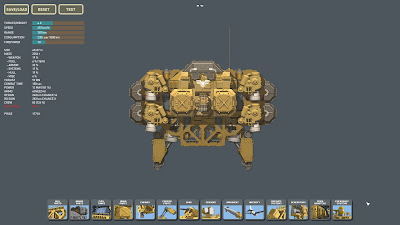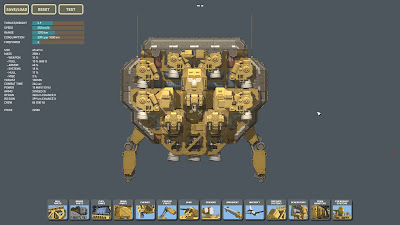Thoughts, musings, ideas and occasionally short rants on the past, present and future of electronics entertainment
Wednesday, March 30, 2022
Wednesday, March 23, 2022
Cycles, not Sagas
The inclusion of open-world mechanics hasn't altered the rhythms that we have all come to expect from Miyazaki Hidetaka, aside from a greater degree of flexibility. Players are no longer required to pursue only one or two options. Instead, they can choose from a wide variety of tactics and character builds, all of which are equally viable. For me, it's actually somewhat of a problem in that I currently have five different characters (a samurai, a knight, a priestess, a barbarian, and a mage) that I keep bouncing between, unable to commit to any one class for the duration. This problem even extends to the moment-to-moment gameplay in that I spent my first hour or so with Elden Ring avoiding combat entirely; preferring stealth and exploration over fighting. Even now (many hours into the game) I find myself reluctant to get into any boss battles. Normally they are a highlight of these kinds of games, but I've come to the conclusion that I don't enjoy the challenge very much. Way too much dodging is required and the opportunities to counterattack are too few/narrow. As if slowing chipping away at massive health bars wasn't tedious enough, there's a tendency in newer From Software games to have boss enemies go berserk or power up when their health drops bellow the halfway mark. Oftentimes this results in the death of the player character which, in turn, means starting the encounter over from the beginning. That personal gripe aside, Elden Ring is a much more forgiving game than any of it's predecessors. There is no "hollowed" state that reduces your max HP, horseback combat is a breeze and computer-controlled allies are just a bell ring away.
I've heard that using sorceries also greatly reduces the overall challenge, but based on my own experiences that really isn't the case. As far as I can tell, a classic sword and shield fighter is the easiest archetype to play. Outside of the mandatory boss battles, most combat in Elden Ring hardly feels worth the effort. There are "runes" to be gained, but the amounts aren't generous and most loot will be of little use to any given character class. For example a low strength build will never be able to wield "great" weapons (of which there are many). Quite a few special abilities also lack practicality; relegating them to amusing novelties at best.
Despite my criticisms, Elden Ring is an impressive accomplishment (even by From Software standards). It sounds like the game has attracted a lot of newcomers as well. Maybe I shouldn't be surprised though considering that the overall experience has a lot in common with The Legend of Zelda: Breath of the Wild.
Wednesday, March 16, 2022
Highfleet Construction Yards (Part 3 of 3)
Classification: Auxiliary Corvette
Role: AA Defense Ship
Description: Simple, cheap and a bit of an eyesore, the Sentinel acts as a picket ship (protecting against surprise jet and missile strikes) while scrounging around the flaming wreckage of a victorious battlefield in an attempting to recover valuable salvage.
Classification: Strategic Heavy Cruiser
Role: Air Superiority Ship
Description: Having a 360 degree main battery that costs as much as a light cruiser, the Sovereign is basically a gigantic flying crown for the king of the skies. Highly impractical, but my answer to the question, "What if I could build my own flagship instead of the Sevastopol?"
Classification: Frigate
Role: Aircraft Carrier
Description: The Crossbow is an attempt to improve carrier survivability through various experiments involving an armored flight deck. While still vulnerable on the underside, this particular design can tolerate a degree of punishment to the top.
Classification: Attack Frigate
Role: Air Superiority Ship
Description: A pricey design that was an attempt of mine to integrate a palash defense system that covers every angle of attack. Removing it reduces the cost by a full 12,000 and still leaves you with a decent combat frigate which I like to simply call the "Hawk".
Classification: Corvette
Role: Interceptor
Description: By utilizing the option to place fixed thrusters at 90 degree intervals (introduced in version 1.15 of the game), the Hyena is faster, cheaper and has better range than the Lightning. Loaded up with special ammo it can be quite deadly, but must dodge constantly due to it's fragile design.
Classification: Frigate
Role: Air Superiority Ship
Description: Fiddling around with different configurations and layouts, I basically stumbled on a design that is identical to the Lynx in every way except the shape. For the sake of variation though it is presented here with a trio of 57mm guns rather than the Lynx's 37mm and 100mm armament.
Click here to go to a shared folder containing all the data files for the ships.
Tuesday, March 8, 2022
Highfleet Construction Yards (Part 2 of 3)
Classification: Light Cruiser
Role: Air Superiority Ship
Description: Able to project a wall of flack in any direction, the Duelist is quite expensive, but also quite resilient. It can shoot down missiles and destroy incoming high caliber rounds with ease. Meanwhile, its armor will stop smaller rounds from inflicting structural damage.
Classification: Heavy Corvette
Role: Tanker
Description: A cheaper alternative to the default tanker. Mules are ideal for extending the range of player controlled ships that are trying to operate independent of the Sevastopol. While unarmed and unarmored, their distinctive shape gives them some chance of surviving an air raid or a hit from a cruise missile.
Classification: Attack Corvette
Role: Air Superiority Ship
Description: The Dervish is an attempt to pack a rocket/missile launcher platform into the smallest frame possible. It is not expensive and has respectable speed, but lacks range and the ability face off against numerous foes. Recommended tactics are to flee if surrounded and re-engage later.
Classification: Strategic Corvette
Role: Missile Carrier
Description: The default missile carriers (Yars, Triumph, Tarantula, Egida, etc.) function well enough, but only have an even number of launchers (either 2 or 4). Why not split the difference with three tubes?...and provide the player with some defenses should they find themselves on the receiving end of a long range strike.
Classification: Light Cruiser
Role: Air Superiority Ship
Description: While shown here fully armed, the idea behind the Cyclops is an initial cost saving strategy. By removing the guns the price is cut in half. Purchase it at the start of a new campaign in this unarmed form, then transfer over the big 180mm six-shooter that comes on the Sevastopol (plus four secondary guns of your choice) at the first opportunity. Congratulations! You now have a powerful and yet expendable cruiser that only cost about 27,000 credits.
Classification: Light Corvette
Role: Aircraft Carrier
Description: Designed as a "pocket carrier," the Chakram is a swift and inexpensive scout with decent range. While unarmored, it does have two aircraft that can give it a small amount of striking power. More importantly though these two jets are well suited to recon work.
Tuesday, March 1, 2022
Highfleet Construction Yards (Part 1 of 3)
Disclaimer: Most of the vessels presented here are not original creations on my part. They were derived from suggestions made on the Steam and Reddit sub-forums for Highfleet. That said, I did not copy and paste any of these war machines. Additionally, they all saw extensive tweaks and overhauls in order to get the maximum amount of viability out of each design.
Overview: Before getting into the stats for individual ships, I think it would be a good idea to touch on three key points of fleet doctrine which guided the general design philosophy on display here. The first is speed. Basically, there are one of two categories to aim for - slow or fast. "Slow", in this case, means keeping up with the Sevastopol (100 give or take). "Fast" is standing a decent chance of getting a sudden strike on local garrisons (around 300). Any ship significantly outside of these two ranges (or directly between them) is going to slow down the reset of the squadron or fly at suboptimal speed themselves. Either way it's inefficient. Second is range. More is obviously better, but not at the expense of combat effectiveness. The distance between towns varies, but always seems to be somewhere between 850 and 1500. Having less than this range leads to an easily stranded ship in constant need of attention from fuel tankers. The third and final point is cost. I have seen a lot of airborne monsters that will pretty much thrash any opposition, but as a consequence they are outrageously expensive. The real challenge of the Highfleet editor, in my opinion, is to build ships that aren't cost prohibitive yet still capable of fulfilling their intended roles. So, keeping those three criteria in mind, here are some designs.
Designation: LynxClassification: Attack Frigate
Role: Air Superiority Ship
Description: Serving as compromise between armor, firepower, speed and range, the Lynx is well suited to clearing out lesser garrisons or capturing prize trade ships. Ideally the Lynx should pounce on targets with close-range bursts of 100mm cannons while using its Gatling gun to shootdown incoming missiles.
Classification: Attack Frigate
Role: Air Superiority Ship
Description: Armed with a pair of the heaviest cannons in the game, the Bulldog is a small ship expressly made to take down enemies much larger than it. Against foes of equal or smaller size it fairs poorly unless proximity rounds are employed, in which case it can dispatch them with relative ease.
Role: Air Superiority Ship
Description: Taking the tried-and-true quad-turret arrangement and applying to 130mm cannons, the Puma is well suited to a snipe-and-dodge style of aerial combat. Due to the lack of any rapid fire weapons, a flare system has been installed to ward off incoming missiles.
Classification: Heavy Corvette
Role: Aircraft Carrier
Description: Being able to deploy jet aircraft on a budget is what the Shortbow is all about. At less than half the price of its bigger sister (the Longbow), this light carrier still has decent striking power. In a pinch, the Shortbow can also share its ample fuel reserve to extend the range of other ships.
Classification: Auxiliary Corvette
Role: Early Warning Ship
Description: While the Sevastopol comes with an impressive array of both passive and active sensors, there are times when a cheap semi-expendable scout ship can come in handy; creating diversions, visiting intel sites, and hunting for hidden rest stops are just a few examples. It is also equip with a jammer and anti-missile system though lacks offensive weapons
Classification: Attack Frigate
Role: Air Superiority Ship
Description: No matter how agile or well outfitted you're going to get hit sooner or later. This means landing in a dock for repairs is an unavoidable necessity. Big ships can either go wide, landing on multiple pads for a bigger bonus, or they can go tall and narrow so they can slip into those sunken 70 meter pads that offer faster repair speeds. Vanguard is the latter.

























